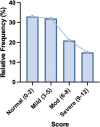Mental health differences in medical students based on curriculum and gender
- PMID: 38115013
- PMCID: PMC10731840
- DOI: 10.1186/s12909-023-04946-2
Mental health differences in medical students based on curriculum and gender
Abstract
Background: The prevalence of mental health struggles among students in medical school is widely reported; however, little is known about how it is impacted by the medical school curriculum. This study aimed to evaluate differences in anxiety, depression, and emotional exhaustion in medical students based on gender, class year, and curriculum.
Methods: An anonymous online survey consisting of questions from established, validated questionnaires about demographics, anxiety, depression, emotional exhaustion, and personal health behaviors was sent to 817 medical students who attended Rowan-Virtua School of Osteopathic Medicine during the Spring of 2021. When applying to this school, each of these students had the option to choose either the problem-based learning (PBL) or lecture-based learning (LBL) curriculum track.
Results: The survey was completed by 222 students. Females experienced higher levels of anxiety, depression, and emotional exhaustion than males. Students in the PBL had lower levels of emotional exhaustion than their peers in the LBL. Increase in emotional exhaustion was most pronounced between 1st and 2nd year students. Emotional exhaustion was inversely correlated with sleep and exercise.
Conclusions: On average, students who were either male or in the PBL curriculum experienced less mental distress in the form of anxiety, depression, and emotional exhaustion than their peers. While gender continues to be an established factor in how mental distress is experienced, the reduced levels of emotional exhaustion in PBL students is a novel finding that can potentially shed light on how to better optimize medical education. Despite the inherent selection bias and lower number of PBL students, to our knowledge, this is the first study comparing two different curricula within a single institution. This finding along with a focus on good sleep and exercise habits may provide a path for improving mental health in medical students.
Keywords: Anxiety; Curriculum; Depression; Emotional exhaustion; LBL; Medical students; PBL.
© 2023. The Author(s).
Conflict of interest statement
The authors declare no competing interests.
Figures








Similar articles
-
Trainees' preferences regarding choice of place of work after completing medical training in traditional or problem-based learning/community-based education and service curricula: a study in Ghanaian medical schools.Rural Remote Health. 2019 Sep;19(3):5087. doi: 10.22605/RRH5087. Epub 2019 Sep 3. Rural Remote Health. 2019. PMID: 31476873
-
Non-cognitive characteristics of medical students: entry to problem-based and lecture-based curricula.Med Educ. 1996 May;30(3):179-86. doi: 10.1111/j.1365-2923.1996.tb00740.x. Med Educ. 1996. PMID: 8949551
-
Problem-based versus conventional curricula: influence on knowledge and attitudes of medical students towards health research.PLoS One. 2007 Jul 18;2(7):e632. doi: 10.1371/journal.pone.0000632. PLoS One. 2007. PMID: 17637847 Free PMC article.
-
Learning contexts at two UK medical schools: a comparative study using mixed methods.BMC Res Notes. 2012 Mar 19;5:153. doi: 10.1186/1756-0500-5-153. BMC Res Notes. 2012. PMID: 22429681 Free PMC article.
-
Caffeinating the PBL return session: Curriculum innovations to engage students at two medical schools.Acad Med. 2014 Nov;89(11):1452-7. doi: 10.1097/ACM.0000000000000395. Acad Med. 2014. PMID: 24988419 Review.
Cited by
-
Unraveling psychological burden: the interplay of socio-economic status, anxiety sensitivity, intolerance of uncertainty, and stress in first-year medical students.BMC Med Educ. 2024 Aug 29;24(1):945. doi: 10.1186/s12909-024-05924-y. BMC Med Educ. 2024. PMID: 39210353 Free PMC article.
-
A Critical Narrative Review of Medical School Curricula: Teaching Methods, Assessment Strategies, and Technological Integration.Cureus. 2025 Apr 10;17(4):e82015. doi: 10.7759/cureus.82015. eCollection 2025 Apr. Cureus. 2025. PMID: 40351904 Free PMC article. Review.
-
Compulsive sexual behavior, sexual functioning problems, and their linkages to substance use among German medical students: exploring the role of sex and trauma exposure.Front Psychol. 2024 Dec 4;15:1423690. doi: 10.3389/fpsyg.2024.1423690. eCollection 2024. Front Psychol. 2024. PMID: 39712546 Free PMC article.
-
Developing a mindfulness program for pre-clinical medical students in Indonesia: a mixed-methods study on suitability and appropriateness.BMC Med Educ. 2025 Jul 17;25(1):1072. doi: 10.1186/s12909-025-07642-5. BMC Med Educ. 2025. PMID: 40676531 Free PMC article.
-
Association of early parent-child separation with depression, social and academic performance in adolescence and early adulthood: a prospective cohort study.Child Adolesc Psychiatry Ment Health. 2024 Jun 26;18(1):78. doi: 10.1186/s13034-024-00769-1. Child Adolesc Psychiatry Ment Health. 2024. PMID: 38926788 Free PMC article.
References
-
- Freudenberger HJ. Staff burn-out. J Soc Issues. 1974;30(1):159–165. doi: 10.1111/j.1540-4560.1974.tb00706.x. - DOI
MeSH terms
LinkOut - more resources
Full Text Sources

